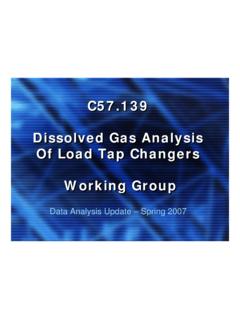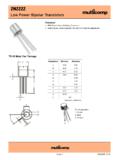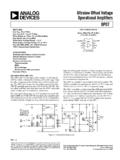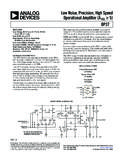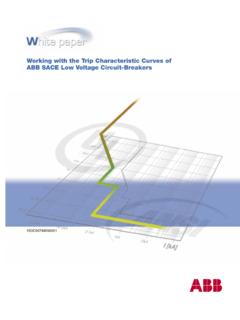Transcription of 5.5 Voltage ratings and taps - Transformers Committee
1 IEEE Std IEEE STANDARD FOR STANDARD GENERAL REQUIREMENTS FOR LIQUID-IMMERSED DISTRIBUTION, POWER, AND REGULATING Transformers Voltage ratings and taps General Standard nominal system voltages and maximum system voltages are included in ANSI and listed in Tables 4 and 5 in this document. Voltage ratings The Voltage ratings shall be at no load and shall be based on the turns ratio. ratings of transformer taps Whenever a transformer is provided with taps from a winding for de-energized operation, they shall be full-capacity taps. Transformers with load tap-changing equipment may have reduced capacity taps, unless specified otherwise, for taps below rated winding Voltage . When specified, other capacity taps may be provided. In all cases, the capacity shall be stated on the nameplate. Connections Standard connection arrangements are included in the standards for particular types of Transformers and in IEEE Std [B18].
2 Polarity, angular displacement, and terminal marking Polarity of single-phase Transformers Single-phase Transformers 200 kVA and below with high- Voltage ratings of 8660 V and below (winding Voltage ) shall have additive polarity. All other single-phase Transformers shall have subtractive polarity. Angular displacement (nominal) between voltages of windings for three-phase Transformers The angular displacement between high- Voltage and low- Voltage phase voltages of three-phase Transformers with - or Y-Y connections shall be zero degrees. The angular displacement between high- Voltage and low- Voltage phase voltages of three-phase Transformers with Y- or -Y connections shall be 30 , with the low Voltage lagging the high Voltage as shown in Figure 1. The angular displacement of a polyphase transformer is the time angle expressed in degrees between the line-to-neutral Voltage of the reference identified high- Voltage terminal H1 and the line-to-neutral Voltage of the corresponding identified low- Voltage terminal X1.
3 NOTE Additional phasor diagrams are described in IEEE Std [B18]. IEEE Std IEEE STANDARD FOR STANDARD GENERAL REQUIREMENTS FOR LIQUID-IMMERSED DISTRIBUTION, POWER, AND REGULATING Transformers Figure 1 Phase relation of terminal designation for three-phase Transformers Terminal markings Terminal markings shall be in accordance with IEEE Std [B18]. Impedance The impedance shall be referred to a temperature equal to the sum of the rated average winding temperature rise by resistance, plus 20 C. Preferred standard values of impedance are included in the product standards for particular types of Transformers . Total losses The total losses of a transformer shall be the sum of the no-load losses and the load losses. The losses of cooling fans, oil pumps, space heaters, and other ancillary equipment are not included in the total losses. When specified, power loss data on such ancillary equipment shall be furnished. The standard reference temperature for the load losses of power and distribution Transformers shall be 85 C.
4 The standard reference temperature for the no-load losses of power and distribution Transformers shall be 20 C. For Class II Transformers , control/auxiliary (cooling) losses shall be measured and recorded. All stages of cooling, pumps, heaters, and all associated control equipment shall be energized, provided these components are integral parts of the transformer. H2 CONNECTION Y CONNECTION Y Y CONNECTION Y CONNECTION H1 H3 X2 X1 X3 X2 X3 X1 H2 H1 H3 X1 X3 X1 X3 X2 X2 H1 H3 H1 H3 H2 H2 IEEE Std IEEE STANDARD FOR STANDARD GENERAL REQUIREMENTS FOR LIQUID-IMMERSED DISTRIBUTION, POWER, AND REGULATING Transformers Insulation levels Transformers shall be designed to provide coordinated low-frequency and impulse insulation levels on line terminals and low-frequency insulation levels on neutral terminals. The primary identity of a set of coordinated levels shall be its Maximum System Voltage and Basic Lightning Impulse Insulation Level (BIL).
5 BIL will be selected dependent on the degree of exposure of the transformer and characteristics of the over- Voltage protection system. Power Transformers are separated into two different classes as follows: a) Class I power Transformers shall include power Transformers with high- Voltage windings of 69 kV and below. b) Class II power Transformers shall include power Transformers with high- Voltage windings from 115 kV through 765 kV. The following tables on subsequent pages show various system voltages, insulation and test levels for various classes of liquid-immersed power Transformers . - Table 4 lists Dielectric Insulation Levels for Distribution and Class I Transformers - Table 5 lists Dielectric Insulation Levels for Class II Transformers - Table 6 lists the High Frequency Test Levels. - Table 4:Distribution and Class I Transformers , voltages in kVMax SytemNominal System Applied Test Induced Test (phase to ground) Winding Line-end BIL Neutral BILV oltageVoltageDelta & Fully Gr YImpedance2 timesMin.
6 AlternatesGrYImpedance InsulatedGr Y Nominal VoltageGr YCol 1 Col 2 Col 3 Col 4 Col 5 Col 6 Col 7 Col 8 Col 9 Col 10 Col 11 Col 12 Distribution Class I Power :1 For Nominal System Voltage greater than Maximum System Voltage use the next higher Voltage class for applied test levels. Induced tests shall be conducted at * Nominal typeface BIL's are standard levels. 3Y-Y connected Transformers using a common solidly grounded neutral may use neutral BIL selected in accordance with the low Voltage winding rating. IEEE Std IEEE STANDARD FOR STANDARD GENERAL REQUIREMENTS FOR LIQUID-IMMERSED DISTRIBUTION, POWER, AND REGULATING Transformers Table 5:Class II Power Transformers , voltages in kV MaxNominal Applied Test Induced Test (phase to ground) Winding Line-end BIL Neutral BILS ystem SystemDelta & Fully Gr Y ImpedanceEnhancedOne Hour Min.
7 AlternatesGr YImpedanceVoltageVoltageInsulatedGr Y7200 YCol 1 Col 2 Col 3 Col 4 Col 5 Col 6 Col 7 Col 8 Col 9 Col 10 Col 11 Col 12 Col 13 Low Voltage Windings (69 kV and lower)<=17<= High Voltage Windings (115 kV and higher)121115173349512010535045055011025 0145138207349514512545055065011025016916 1242341401701455506507508251103502422303 4534140240210650750825900110350362345518 3414036031590010501175110350550500N/A341 40550475142515501675110350765735N/A34140 85075019502050110350800765N/A34140885795 19502050110350 Notes:1 For Nominal System Voltage greater than Maximum System Voltage use the next higher Voltage class for applied test levels. Induced tests shall be conducted at * Nominal Voltage for one hour and * Nominal Voltage Ofor enhanced 7200 cycle typeface BIL's are standard connected Transformers using a common solidly grounded neutral may use neutral BIL selected in accordance with the low Voltage winding 735kV to 800 kV nominal system voltages, induce test levels do not follow rules in Note 2, and 1950 kV BIL is not a standard IEEE level.
8 Line terminals Basic lightning impulse insulation level (BIL) A basic lightning impulse insulation level (BIL) from Table 4 shall be assigned to each line terminal of a winding. The associated insulation levels shall be provided regardless of whether tests are or can be performed. Switching impulse insulation level Windings for system voltages 115 kV and above shall be designed for the switching impulse insulation levels (BSL) associated with the assigned BIL as shown in Table 6. In addition, low- Voltage windings shall be designed to withstand stresses from switching impulse tests on high- Voltage windings regardless of whether or not such tests are specified. Front-of-wave insulation level Front-of-wave insulation levels and tests shall be specified when desired; otherwise, withstand insulation capability is not required. See Annex A for table of historical Voltage levels and wave shape characteristics.
9 Wye-winding line terminal Each wye-winding line terminal shall be specified as suitable or unsuitable for ungrounded neutral operation. IEEE Std IEEE STANDARD FOR STANDARD GENERAL REQUIREMENTS FOR LIQUID-IMMERSED DISTRIBUTION, POWER, AND REGULATING Transformers Table 6: High Frequency Test TablesLightning Chopped WaveSwitchingImpulse (BIL)kV CrestMin. Time to Flashover, sImpulsekV Crest, X BILC lass I & DistClass IIkV Crest, X BILCol 1 Col 2 Col 3 Col 4 Col : 1. Switching impulse tests are not always possible for low Voltage windings. 2. 1550 kV for the 1950 kV BIL is a special application used by a utility that uses transpositionto reduce switching impulse levels. Non-transposed lines should use 1620 kV for 1950 kV BIL. Windings that have no terminals brought out Windings that have no terminals brought out shall be capable of withstanding voltages resulting from the various tests that may be applied to other terminals corresponding to their respective BIL.
10 Neutral terminals Wye connection with an accessible neutral external to the tank A transformer winding designed for wye connection only and with an accessible neutral external to the tank shall be assigned a low-frequency test level for the neutral terminal. This assigned low-frequency test level may be lower than that for line terminals. Neutral terminals that are solidly grounded IEEE Std IEEE STANDARD FOR STANDARD GENERAL REQUIREMENTS FOR LIQUID-IMMERSED DISTRIBUTION, POWER, AND REGULATING Transformers The assigned low-frequency test level for neutral terminals that are solidly grounded directly or through a current transformer shall be not less than that specified in Column 4 of Tables 4 & 5. The assigned low-frequency test level for other cases shall be coordinated with voltages that can occur between the neutral and ground during normal operation or during fault conditions, but shall be not less than those specified in Columns 3, 4, & 5 of Tables 4 & 5.
